By Jamie Blaine
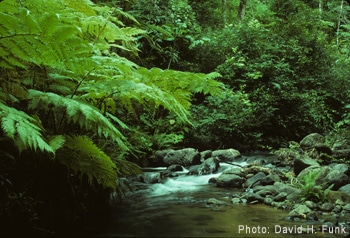
From the beginning, Maritza has rewarded Stroud researchers with unexpected insights. Because the area around the station is remote and undeveloped, the streams run clear and clean.
The first thing that strikes a visitor to Maritza Biological Station, Stroud Water Research Center’s tropical campus in northwestern Costa Rica, is the remote beauty of the place. Set at the foot of the majestic Orosí volcano, Maritza looks west across Área de Conservación Guanacaste (ACG) to the Pacific Ocean. In the evening, after the sun has dropped below the horizon in a brilliant ball of colors, the only visible lights are the few cars traveling on the Pan-American Highway that bisects the park, the flickering lamps of a small community, and the vast expanse of the Milky Way.
“In the dry season,” said Bern Sweeney, “I can walk into the forest and within 20 minutes have crossed six streams whose water is clean enough to drink with my hands, and I am reminded that this is how it used to be everywhere.”
Río Tempisquito, the stream that flows nearest to the station, might be described as the southern branch of White Clay Creek. Stroud Center scientists have been conducting original research in it since 1988. The work they do trying to unlock the secrets of freshwater ecosystems is very much like the work they do at the Stroud Center’s main campus in Avondale, Pennsylvania, except that the stream they study is tropical and the language they speak, however haltingly, is Spanish.
The Stroud family established Maritza in response to a request from noted evolutionary ecologist Dan Janzen to help create a park in which 90 percent of all species could be protected for 1,000 years. The result is the 300,000-acre ACG, one of the most diverse regions of the world, a critical “hot spot” for biodiversity protection, and a “water machine” that provides clean water for drinking, agriculture, and industry in the relatively arid northwestern Costa Rica.
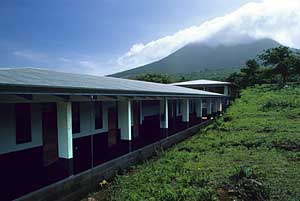
Maritza Biological Station, with Orosí volcano in the distance
The Stroud Center’s role, said Steve Stroud, who has served on the boards of both ACG and Stroud, is to (1) understand the area’s freshwater ecosystems, (2) provide the scientific data essential for effective and enduring preservation strategies, and (3) educate the region’s people about the importance of their fresh water and the stewardship practices required to protect it.
Over Maritza’s history, Stroud Center scientists have vastly expanded their own and the world’s knowledge of tropical ecosystems, and they have shared their data with park officials who use it to make critical decisions about the region’s future. One result has been the creation of the only interdisciplinary database on freshwater ecology in the entire tropics. Another has been the creation of a replicable model that combines scientific research, biodiversity conservation, and economic development in an effort to produce a healthy environment and stable communities.
A HISTORY OF EXCITING RESEARCH
From the beginning, Maritza has rewarded Stroud researchers with unexpected insights. Because the area around the station is remote and undeveloped, the streams run clear and clean. But the scientists quickly discovered they are not pristine. Early studies revealed minute traces of pesticides in the water, which further research revealed had been carried west by the trade winds from the sugar plantations of the Caribbean, demonstrating once more that pollution is a global issue that knows no national borders.
“We started the research program because we realized that tropical stream ecosystems, with nearly constant water temperatures year round and almost three meters of rainfall concentrated in a rainy season, differ significantly from temperate ones,” said Sweeney. “Maritza was a long-term commitment to understand how natural tropical streams work and to provide a natural forest gradient from evergreen to deciduous that allows us to test theories about all stream ecosystems.”
Just as they had in Pennsylvania, Stroud researchers studied natural streams that would serve as a baseline for understanding, measuring, and eventually restoring polluted streams. Maritza, said Sweeney, is “the critical hub” for that effort, yielding knowledge that can be applied to tropical streams around the world.
What they had not anticipated was how important their work would become to the local communities, the Guanacaste region and the nation. “In Costa Rica, Maritza is held up as a model of how to use critical scientific research to build community awareness,” said Steve Stroud. “They understand the importance of our research to the protection of irreplaceable water resources.”
TWO PROJECTS
Two current projects highlight both the importance of Maritza to the Center’s overall vision and also how the diverse strands of that vision have become interwoven over time.
The first involves the collection of long-term data about the basic dynamics of the stream, which can be used as a baseline to measure other streams throughout the tropics. Led by John Jackson, the National Science Foundation (NSF)–funded Long Term Research in Environmental Biology (LTREB) has expanded to eight sites that span the spectrum from wet forests to dry forests. Created in the image of the Stroud Center’s LTREB on White Clay Creek, Jackson’s multiyear study seeks to quantify changes over time and “explore the role of large-scale climatic processes (i.e., El Niño/La Niña) in the ecology of the streams across different years.”
The second project, also funded by NSF, builds on almost the entire history of the Stroud Center’s research. “The idea,” said Principal Investigator Lou Kaplan, “is to exploit new methods in molecular microbial ecology and molecular-scale analytical organic chemistry to test ideas first proposed by the River Continuum Concept (RCC).”
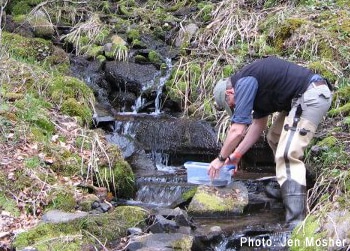
Sherman Roberts collecting rocks from the Neversink River. The thin film of microorganisms that live on them will be studied back in the laboratory.
Conceived at the Center in the 1970s by then-director Robin Vannote, the RCC revolutionized the study of freshwater ecosystems. Vannote’s 1980 paper describing the concept is still the most often-quoted scientific paper on stream ecology. But many of the processes Vannote and his colleagues hypothesized could not be verified at the time because the technology to do so did not exist. Consequently, researchers have been wrestling with its ramifications ever since, and now Kaplan and his team are employing methods, even fields of science, that were unknown 30 years ago.
Kaplan’s project is almost a microcosm of Stroud Water Research Center’s method and history, building on years of his own and others’ work; employing the most modern technology; collaborating with Jinjun Kan, the Center’s new microbial ecologist, post-doctoral scientist Jennifer Mosher, and Bob Findlay of the University of Alabama; and incorporating both the Center’s and ACG’s education departments to ensure that the findings are turned into programs for the general public, and in particular, for the next generation.
With sites on White Clay Creek, the Neversink River in New York and the Río Tempisquito in Costa Rica, the research team will work in waters ranging from small streams to small rivers in both temperate and tropical zones. Befitting a project of this magnitude, the goal is not to prove or disprove some arcane scientific trivium but to understand how microorganisms process organic carbon dissolved in stream water. “That processing,” said Kaplan, “constitutes a critical link in the global carbon cycle.”
Since its founding almost a quarter century ago, Maritza has become a vital piece of Stroud Water Research Center’s mosaic. It has enabled the scientists to understand streams in an environment that may well hold the key to the earth’s future, to work with researchers and communities in developing countries where the Center’s expertise is in high demand, and to provide Center researchers with knowledge they could get nowhere else.
“Our work at Maritza is critical to our mission,” said Sweeney. “It has enabled us to understand global water and climate issues in ways we could not have done without it.”
LONG-TERM DATA KEY TO NEW TROPICAL STREAM STUDY
When Lars Hedin, a professor of ecology and evolutionary biology at Princeton, set out to determine why nitrogen levels in pristine tropical streams were similar to those found in polluted temperate streams, he turned almost immediately to Maritza.
“Once we started looking for places to test our ideas,” he told a writer for the Princeton Environmental Institute, “we immediately thought of the Stroud Water Research Center. Stroud has a very unique 20-year record of data from undisturbed, natural tropical forest. Their collection is the longest record available over time for concentrations and isotopes. Such data sets are very rare.”
Hedin also asked senior scientists Denis Newbold and John Jackson of the Center to join his research team, which found that, contrary to their assumption, the nitrogen levels were consistently high throughout the 19 years of the Center’s data collection. This has potentially huge implications for global climate models, which have not previously accounted for the vast amounts of stable nitrogen in tropical forests that could be released by increased logging, agriculture, and development.
FROM MARITZA TO PERU
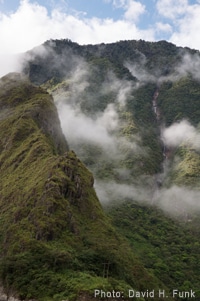
Mountains above Mamabamba, Peru
The drive from Cusco to Puerto Maldonaldo, Peru, is less than 200 miles … straight downhill. You start at well over 11,000 feet, and when you arrive at the port city on the Madre de Dios River, you are exactly 600 feet above sea level. From there you have a 2,000-mile boat ride to the Atlantic Ocean.
Such is the extraordinary topography of South America, where the massive Andes peaks are pushed up against the Pacific Ocean to the west and drain into the vast Amazon basin to the east. That basin is the most important ecological place in the world. Its rain forests and rivers not only provide resources for almost the entire continent, but they also play a critical role in the global climate and water cycles.
Stroud Water Research Center scientists and educators have been working in and around Puerto Maldonado for several years, first under a Moore Foundation grant to the Center and currently in partnership with the Amazon Center for Environmental Education and Research (ACEER), whose home office is at West Chester University in Pennsylvania but whose mission is protecting the Amazon regions of Peru.
The Stroud team has brought with it the foundation in tropical ecology they built at Maritza: (1) understanding the science of tropical streams; (2) the Leaf Pack protocols for assessing water quality; and (3) education programs for teachers, students, and government and conservation leaders that have been translated into Spanish and field tested in both Costa Rica and Peru.
The objective of the ACEER collaboration is to create a comprehensive water-quality baseline along the new road from Cusco to Puerto Maldonado. That road is part of the just-completed Transoceanic Highway, which connects the interior of Brazil to Peru’s Pacific Ocean ports. The 2,600-kilometer highway has opened previously remote parts of the interior to rapid population growth, development, and resource extraction, the impacts of which could have worldwide consequences.
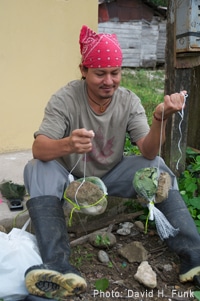
Therany Gonzalez-Ojeda, ACEER Director of Field Operations in Peru, with leaf packs ready for placement in a stream
The scientists have selected 10 paired stream sites, each within one kilometer of the Cusco-Puerto Maldonado highway. One of the paired sites is upstream and removed from any impacts from the road or accompanying land-use changes; the other is downstream and vulnerable to such impacts. By creating a baseline of water quality at the opening of the highway, scientists will be able to assess changes over time; and the paired sites will allow them to determine the role of the highway in those changes. By using Leaf Pack, which has long proved effective as an educational tool for both schools and community organizations, the partnership aims “to disseminate the results in support of village empowerment, conservation, and shared decision making.”
This project demonstrates the core values of Stroud Water Research Center:
- Building on the past. The knowledge and tools the scientists bring to the project were developed at the main campus in Avondale, Pa. and refined for tropical watersheds at Maritza.
- Turning scientific knowledge into broad educational understanding. The project will establish a baseline of great value to the scientific community. The dissemination of simple techniques and protocols to schools and civic groups will ensure that the knowledge is broadly accessible to the local community as well.
- Collaboration. The project requires internal collaboration among both scientists and educators. The external partnership with ACEER has enabled the two organizations to amplify their collective impact on the fate of the Amazon River and rain forests and to address important issues associated with global climate change.



